Type species: Phalaena tau Linnaeus, 1758.
A Palaearctic genus comprising six species, of which Aglia tau occurs right across the northern Palaearctic, except for the British Isles and Japan. Then there is Aglia homora Jordan, 1911, which is endemic to the provinces of Gansu, Shaanxi, Sichuan and Qinghai, China; Aglia japonica Leech, [1889], which is confined to Hokkaido Island, Japan, and Sakhalin Island, Russia; Aglia sinjaevi Brechlin, 2015, from Shaanxi, China; Aglia vanschaycki Brechlin, 2015, from Guizhou, China; and Aglia ingens Naumann, Brosch & Nässig, 2003, from Sichuan, China.
HOSTPLANT FAMILIES: Many trees and shrubs, but with a preference for the Fagaceae.
UK: Tau Emperor, F: Hachette, D: Nagelfleck; Tau-Spinner, RUS: Pavlinoglazka ryzhaya, S: Nagelspinnare, NL: Tauvlinder, CZ: Martináč bukový, H: T-betus pávaszem, E: Cuatrotes, PL: Lotnica zyska, FIN: Nastakehrääjä, DK: Sømplet, N: Naglespinner, EST: Kollapaapusilm.
Phalaena Bombyx tau Linnaeus, 1758, Syst. Nat. (Edn 10) 1: 497.Type locality: [Europe].
[Further details on this species, as well as photos of all stages, can be found on Lepiforum.]
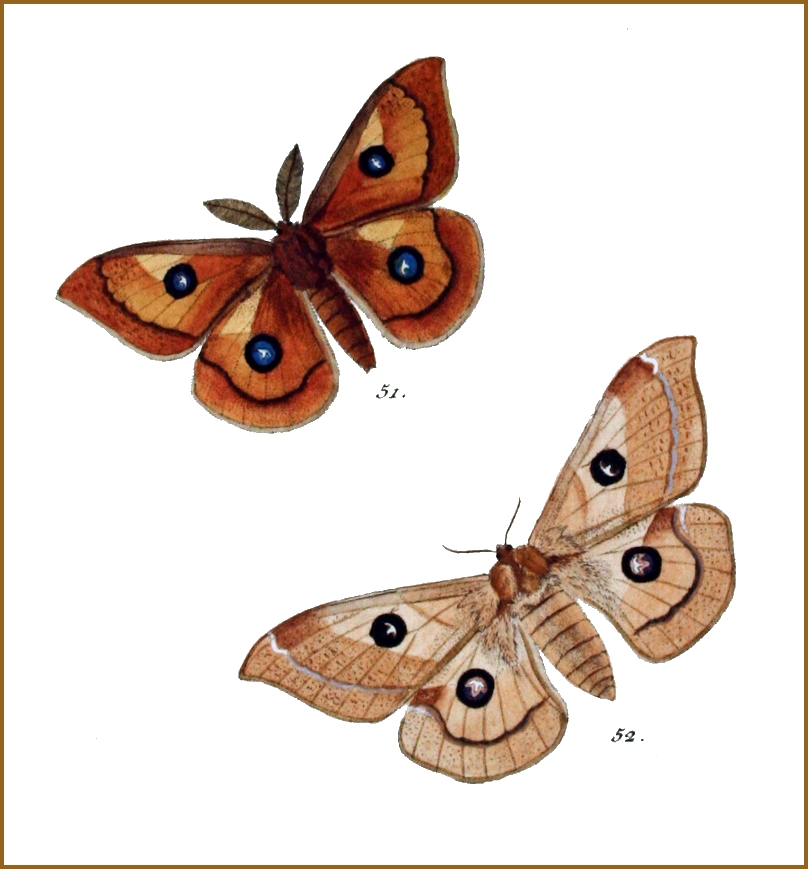
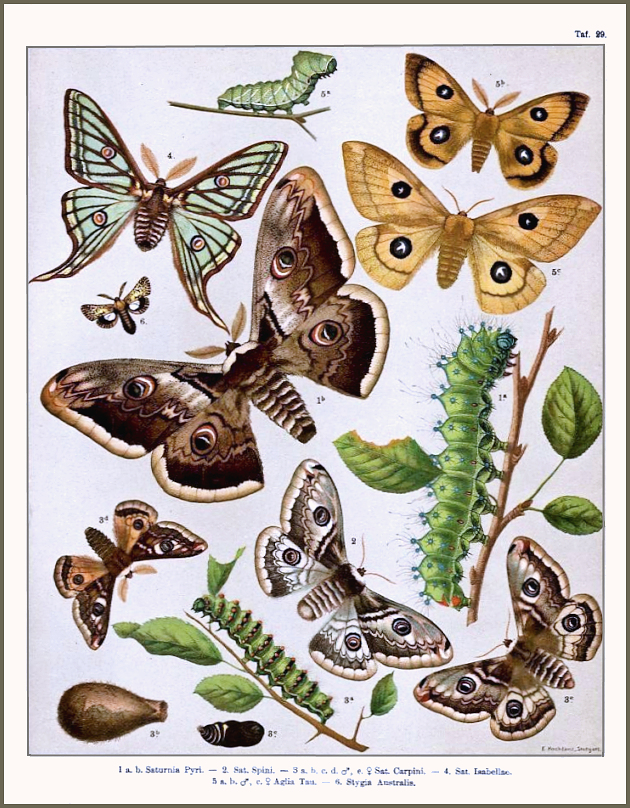
Holarctic; Palaearctic region. Pleistocene refuge: Polycentric.

Wingspan 60--84mm. The sexually dimorphic and dichromatic adults are like no other moth from the region, with the larger females (illustrated) being less well marked and less brightly coloured than males, which have less pointed forewings. Although most adults are yellowish-orange, some are heavily dusted with dark-brown or black scales (f. melaina Gross, 1898); the latter are especially common in cooler, mountainous areas. Other forms include f. ferenigra Thierry-Meig, 1884, in which the submarginal areas of all wings are heavily dusted with dark scales; f. cerberus Schultz, 1905, in which the hindwings are black; f. cupreola Werner, 1902, in which the females are copper-red; and f. decolor Schultz, 1905, in which both sexes are pale. There are many more forms in this variable species, too many to be mentioned here. In the Pyrenees mountains males can also be markedly copper-red (f. cupreola), so that they appear reddish on the wing. The eyespots have iridescent purple centres.
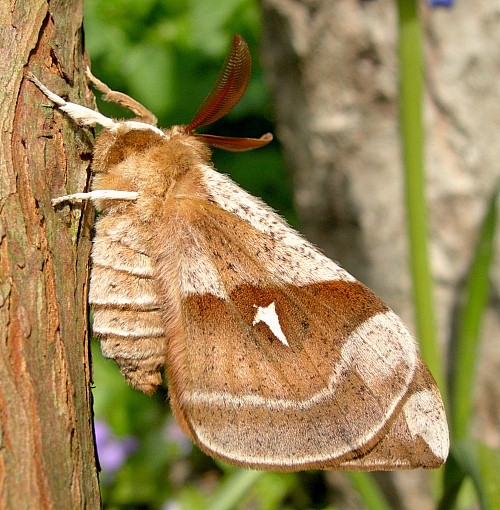
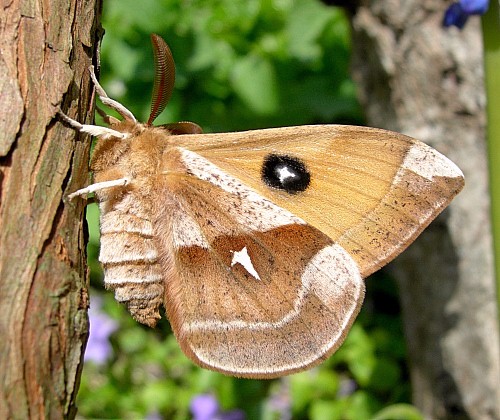
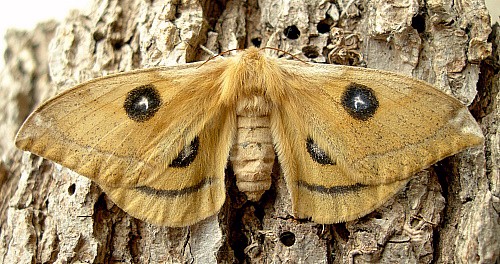
Most adults emerge in the early morning, with females calling/scenting that same morning, often from the base of trees up which they have climbed. Although the females are nocternal, the diurnal males will zigzag wildly through open woodland on sunny mornings (9--11h) in search of these once thay have picked up a scent trail, with several often piling up on the same hapless object of their desire. Pairing lasts for only a few hours. After separation, males fly off to rest and usually cease all activity by mid afternoon. Come evening, the female climbs to the highest vantage point possible before launching herself clumsily towards the nearest shadow which, often as not, is a tree. When at rest both sexes generally sit on tree-trunks or the forest floor with their wings closed vertically over the abdomen.
On sunny mornings in the Pyrenees Mountains the reddish males (f. cupreola) will often cruise/flutter leisurely several metres above ground level across open areas in search of female scent trails. In such mode they can easily be mistaken for butterflies, particularly Nymphalis polychloros (Linnaeus, 1758) (Pittaway, pers. obs. 2016).
This is a species of deciduous forests up to 1600m altitude, showing a preference for beech (Fagus) woodland.
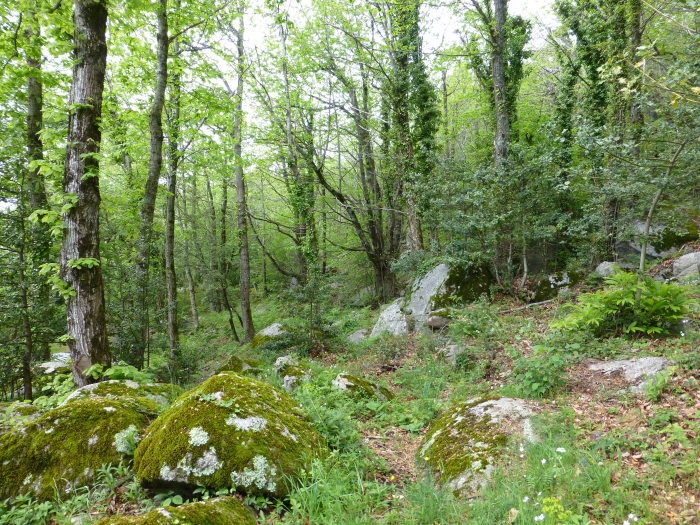
Depending on latitude and altitude, late March to the beginning of June as a single generation, which coincides with the appearance of leaves on the trees.
OVUM: Cylindrical with rounded ends; 2.5 x 1.9mm; usually dark-chestnut but sometimes cream. Laid in rows of up to ten on the branches and trunks of trees, usually hatching 10 to 12 days later.
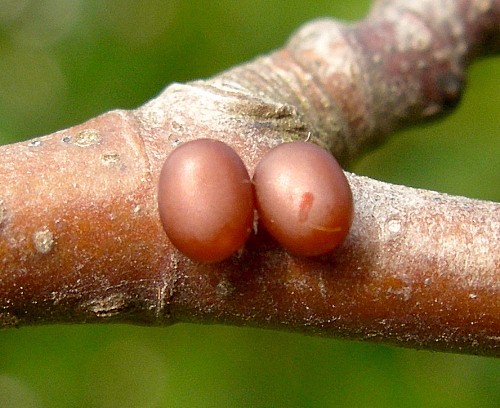
LARVA: Full-fed 60mm. Monomorphic.
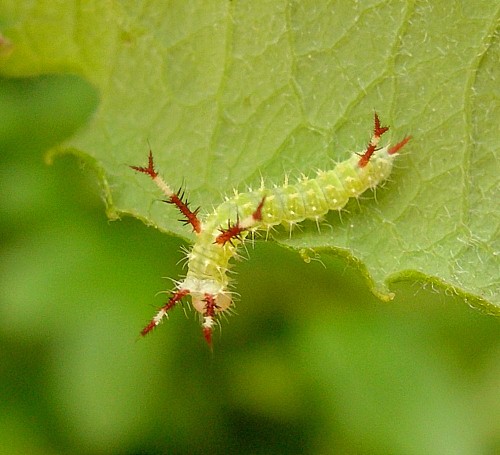
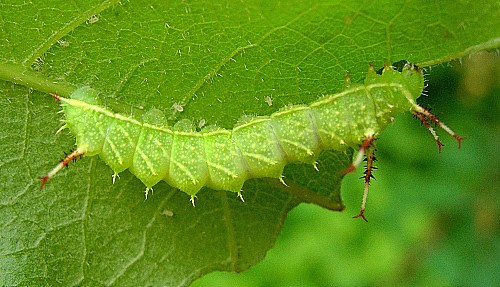
The newly-hatched, 5mm long larvae is spectacular. Although the head and body are pale green, two red and yellow bifurcated spiny 'horns' project forward from segment one, with another pair projecting backwards from thoracic segment three. A single horn of the same colour projects up vertically from abdominal segment 7. The body is covered with small yellow tubercles and there is a pronounced subspiracular line of the same colour running from around thoracic segment one to the anal clasper. As the larva grows the 'horns' shrink, disappearing in the final instar, the yellow markings become more intensive, and the segments become sharply humped, giving the body a serrated outline. A single oblique yellow line appears laterally on each abdominal segment, as well as a black-centered red spot on the side of abdominal segment one. This species may go through 4 or 5 instars.
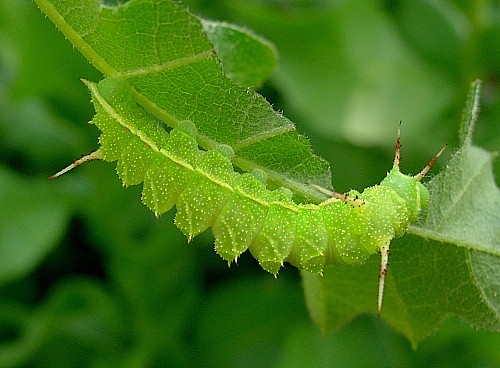
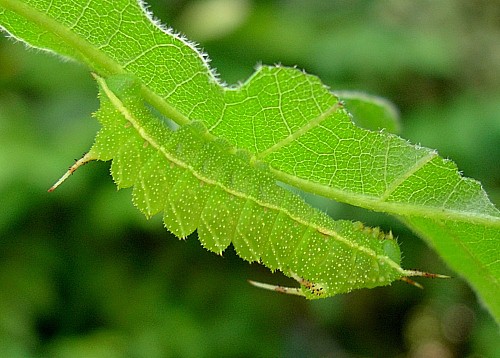
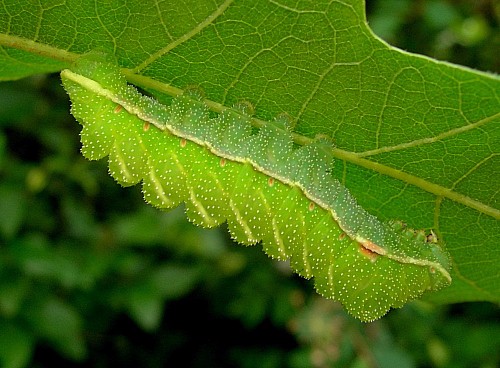
The larvae are initially gregarious, but rapidly become solitary and sedentary. In the later instars they often rest in a rolled-up leaf between feeding bouts.
Hostplants. Many species of tree and shrubs, with a preference being shown for beech (Fagus sylvatica). Also, oaks (Quercus), hornbeams (Carpinus), birches (Betula), maples (Acer), hazels (Corylus), limes/lindens (Tilia), pears (Pyrus), apples (Malus), mountain ash (Sorbus aucuparia), alders (Alnus), hawthorns (Crataegus) and willows/sallows (Salix). In many lowland forests, Tilia and Salix replace beech as the preferred host.
PUPA: 22--27mm. Bullet-shaped, tapering anteriorally. Blackish-brown and rough, with, dorsally, many small thorns on the mobile abdominal segments. Formed in a few strands of silk among litter at the base of a tree. There is no cocoon. The overwintering stage.
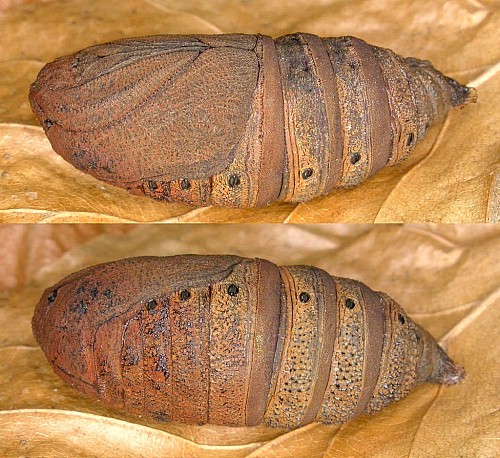
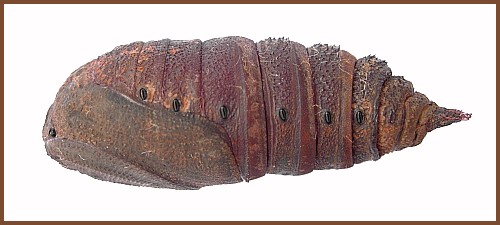
Tachinidae: Drino lota (Meigen, 1824), Senometopia separata (Rondani, 1859).
From northern Spain, France, northern Italy (Parenzan & Porcelli, 2006) and southern Scandinavia across central, northern and eastern Europe to the Ural Mountains (Nupponen & Fibiger, 2002) and western Siberia (Lavrov, 1927; Knyazev, 2020), with isolated populations in the Apennine Mountains east of Florenz, Italy (Dapporto, Fiorini, Fiumi & Flamigni, 2005), in the southern Crimea (Ukraine), the Northern Caucasus (Zolotuhin, Didmanidze & Petrov, 2011), and the western Alborz Mountains (Gilan Province and Mazandaran Province) of northern Iran (Barou, 1967; Rougeot, 1971; Nässig, 1981); recorded from as far north as Arkhangelsk Oblast in european Russia (Kozlov, Kullberg & Zverev, 2014). This species is absent from the British Isles and has not been recorded from northern Turkey, nor the southern Caucasus Mountains.
Extra-limital range. From the Altai Mountains across southern Siberia (Izerskiy, 1999a), northern Mongolia, southern Yakutia (Kaimuk et al., 2005) and Buryatia (Gordeeva, 2015) to the Russian Far East (Sakhalin Island) (Kishida, 2022; Dubatolov, 2023), northeastern China (Heilongjiang, Liaoning and Jilin to Shaanxi) (Zhu & Wang, 1993) and South Korea (Park et al., 2001; Naumann, Brosch & Nässig, 2003).
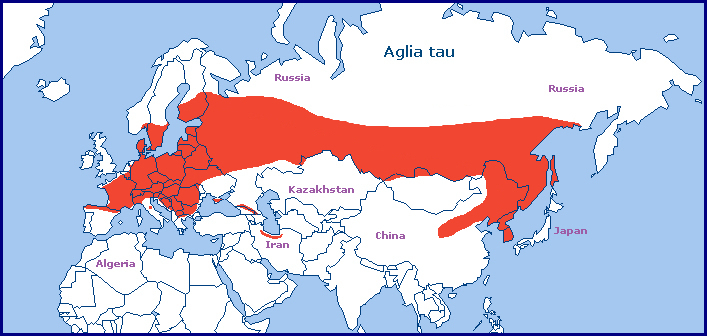
None. The former subsp. microtau Inoue, 1958, is a subspecies of Aglia japonica Leech, [1889], which is endemic to Japan and Sakhalin Island, Russia.
 Return to species list
Return to species list